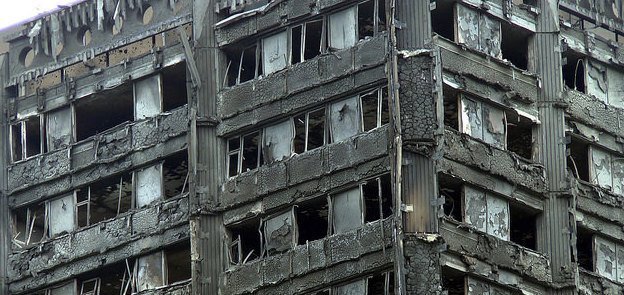Councils need financial support from government to meet the costs of repairs to high rise blocks in the wake of the Grenfell Tower tragedy, according to the Local Government Association.
Authorities around the country are already taking measures to ensure the safety of housing blocks, including testing cladding, checking fire doors and examining gas supplies.
The LGA says it is in discussions with affected councils about the costs they face to carry out works that are deemed necessary.
Simon Blackburn, chairman of the Local Government Association’s Safer and Stronger Communities Board, said: “With test fails affecting buildings owned by a range of different landlords across the country, it is clear that the current building regulation system has failed. It is also clear that councils cannot afford to carry out this work.
“As a result, we remain firmly of the view that the government needs to meet the exceptional cost to councils of removing and replacing cladding and insulation on high-rise blocks.”
Speaking to Room151, Duncan Whitfield, director of finance and governance at London Borough of Southwark, said that the government could take a number of steps to help councils meet the costs.
Southwark, the third largest council landlord in the UK with around 40,000 council homes, has spent more than £64m on fire safety measures since the 2009 Larkanal disaster in Peckham killed six of its tenants.
Last week, the council turned off gas at four tower blocks as a safety measure, with the long-term intention of replacing gas appliances with electric ones.
But Whitfield said: “In London there is a high demand for specialist building contractors including electricians and plumbers. This creates a price premium and often a response that extends timelines for delivery. While safety of residents must always come first, completion of some of the jobs that will be identified cannot be delivered immediately and will in some cases takes weeks and months.”
In addition, following Grenfell, councils will now be reconsidering whether to retrofit council blocks with sprinkler systems.
Whitfield said: “Previously, there may have been a view that sprinklers are more likely to save damage to properties rather than saving lives. In the light of Grenfell, councils will have been reviewing their risk assessments on this point and I am certain that there will be pressure in some cases to look again at sprinkler installation. This will be one of a series of significant new cost pressures to manage. Inevitably this will impact on other investment plans that will include routine repairs and maintenance, refurbishments and new builds.”
The need to refurbish and maintain council housing to safe standards is likely to put pressure on the Southwark’s housing revenue account, which plans to provide 11,000 new council homes over the next 30 years.
Whitfield said that the government should look again at its policy of forcing councils to reduce rents each year.
“That compromises the resource we have to invest in housing. Giving back control of rent to councils would help us enormously. For Southwark, the loss of resources over our thirty years amounts to hundreds of millions when our council rents remain among the lowest in central London.”
He also called on ministers to allow councils to relax rules on the use of receipts from Right to Buy sales on repairs.
He said: “At the moment, we are having to sell properties below market value. We can only keep some of the receipt and our use of what we keep and the time in which we have to spend it is extremely limited. If you can’t spend it all on new builds in a limited period then you have to give it back to government – in the current climate this no longer makes sense. More flexibility could help us manage our planning both for maintenance and for new investments.”
Finally, Whitfield suggested that the government needs to lift the current borrowing cap which applies to housing revenue accounts.
He said: “For Southwark, the borrowing headroom in total – currently c£180m – would fund our housing investment programme for less than two years; for a social landlord of our size, it acts to constrain what we can plan and deliver.
“If there was ever a time to release the borrowing cap, it has to be now.”
He said that under the self-financing HRA regime, the business case to borrow will continue to demand a reliable income stream from rents to be able to repay the borrowing.
“Housing associations are to a great extent built on debt, and as local authorities we could make great advantage from these facilities,” he said.
A Department for Communities and Local Government spokesman said: “We’ve been clear with councils and housing associations that we expect them to do whatever local fire services and experts say is necessary to make residential buildings safe.
“We will ensure that where local fire services have advised works are essential to ensure the fire safety of a building, current restrictions on the use of financial resources will not prevent them going ahead.”













